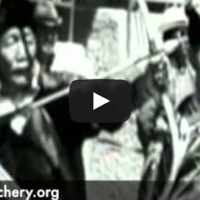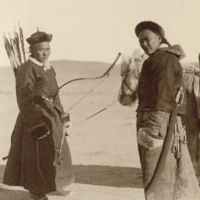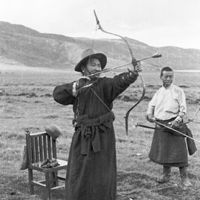There is a persistent myth going around that the Manchus would have banned the Mongolian people from practicing archery during the Qing. In this article I will attempt to clarify this issue. First, let's get into some background on the relationship between the Qing and Mongolian tribes.
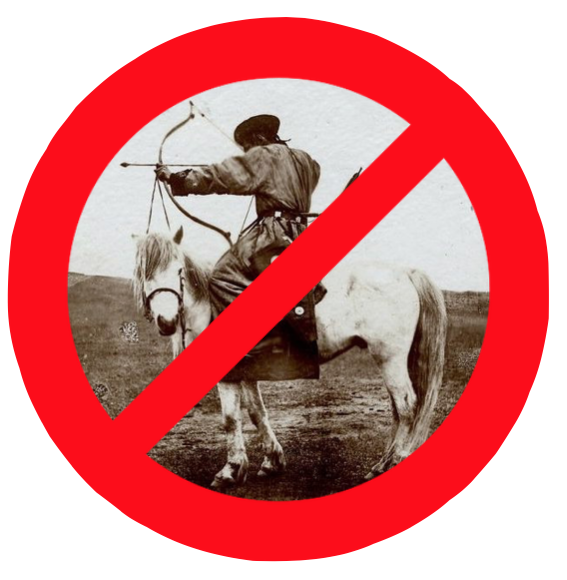
Introduction
In the seventeenth-century the Manchus set out to overthrow the Ming in order to establish their own Qing dynasty. Mongolia was far from a unified country when the Qing came to power, and consisted of many tribes that fought each other. During their rise, Manchu leaders forged alliances with various Mongolian tribes such as the Khalkha and the Chahars who were to be incorporated in the army of the Qing dynasty. The Manchu and Mongolian troops allied under the Qing fought alongside each other to conquer the Ming. They also fought any Mongolian tribes that still opposed the Qing. When the Dzunghars attacked the Khalkhas the Kangxi emperor granted many fleeing Khalkhas asylum under the Qing and set out to a series of punitive expeditions against the Dzunghars that ultimately lead to the extermination of the Dzunghars by Kangxi's grandson, the Qianlong emperor.
The Mongolians that joined the Qing enjoyed the same privileges as the Manchu ruling elite such as monthly pay in silver, rice stipends, and exemption from torture when caught for a crime. Also like the Manchus, they could not take on any other profession than warrior or government official. They were literally "the emperor's men", who was seen as a Khan by his Mongolian subjects. Mongolian tribes that joined during the early stages were enlisted under the Manchu banners, and those that joined after the initial conquest were divided under separate Mongolian banners, but all with the same privileges as the Manchu banners. A lot of intermarriage further strengthened the relationships of the Manchu - Mongol warrior class of the Qing. Right after the fall of the Qing, all bannermen, whether Manchu, Mongolian or Chinese, were considered "Manchu" by the new government. Their ties were that close.
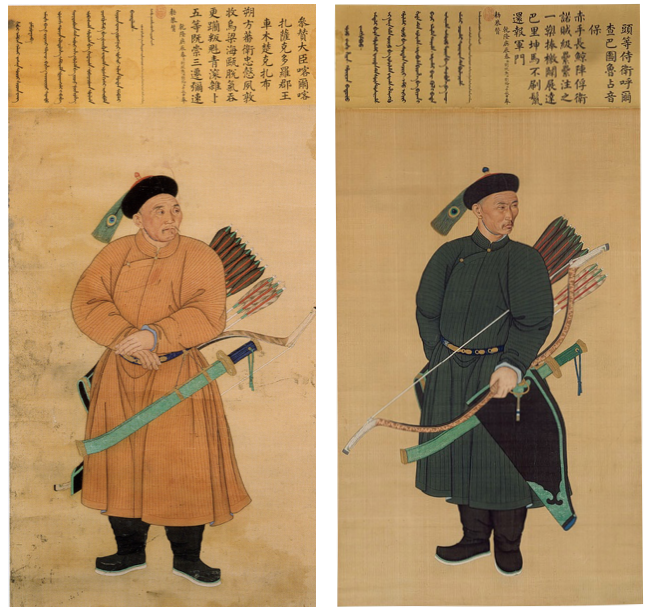
Two portraits honoring war heroes of the 18th century conquests. Left: Khalkha Mongol bannerman Cemcukjab. Right: Manchu bannerman Janggimboo. Note the similarity in their equipment, all standard issue Qing military gear. These men were equals. Serving the Qing dynsty imperial army they lived and fought the same way.
"When Manchus and Mongols go out to hunt in the North we are dealing with a skill that eludes words. The hunters mass like storm clouds, the mounted archers are as one with the horses; they fly together and their arrows bring down the fleeing game. Heart and eye are cheered to see it."
-The Kangxi Emperor
(Translation by professor Jonathan Spence)
Objections!
Given the above it should not come as a surprise that the connection between Manchu and Mongolian archery of the later period is profound as shown among others by a variety of old photographs and early footage. This does not sit well with everybody. Some Mongolian nationalists and die-hard fans of Mongolian archery like to cling to an idea where the (highly mobile) Mongolians lived in a cultural bubble, impenetrable by the influences of neighboring cultures.
Common reactions are: How can Mongolian archery be influenced by Manchu archery? Mongolians practically invented archery! Weren't the Mongols the best known archery people from the region? Feared warriors on fast horses who conquered vast lands under great Khans? The answer to the last question is: Yes, absolutely! And to be honest, we don't even know where Manchu archery originally came from. It most likely derived off eastern Siberian traditions who used rather similar bows up to the 20th century. Cultures most likely continuously influenced each other in the region, this must have went both ways forming a true melting pot of archery exchange in this region. But we do know for a fact that somewhere along the line, it were the Mongolians who moved away from their traditional Mongolian style bows and into the Manchu style bows widely used by the Qing. What most people now regard as a Mongolian traditional bow is actually a modified Qing bow. Munkhtsetseg -six time women's national champion of Mongolia- mentioned in her 1999 article that one of the bows they commonly used was "gung’ – a deep form of bow based on the Manchu style".
Mythbusting
Anyway, let's return to our myth of the Qing ban on Mongolian archery. The three main objections against such a ban ever being in place are lack of motivation, capability, and evidence.
Motivation
This one is very simple: why disarm those you pay to fight on your side?
Capability
Even in the height of the Qing, plenty of Mongolians still fell outside the empire's sphere of influence. And as such, it would be hard for a Qing emperor to tell them what to do and what not to, now would it? Mongolians with their nomadic lifestyles were notoriously hard to control or even track down and it was not like there was a Qing steppe police force.
The Dzungars were a group of Mongolians that opposed the Qing. They fought many battles before they were finally defeated by the Qing armies. If it were the Qing to ban archery among Mongolians, you would expect the Dzungars to still be adhering to their traditional ways of war, with bow and arrow. But here is the thing: lists of equipment taken from defeated Dzungars do not mention any archery related equipment. Instead, firearms and a variety of edged weapons are mentioned.1 This is in accordance to 18th century artwork showing Dzungars engaging primarily with spears, sabers and muskets.
1See Perdue, Peter C., CHINA MARCHES WEST, Belknap Press, 2010.
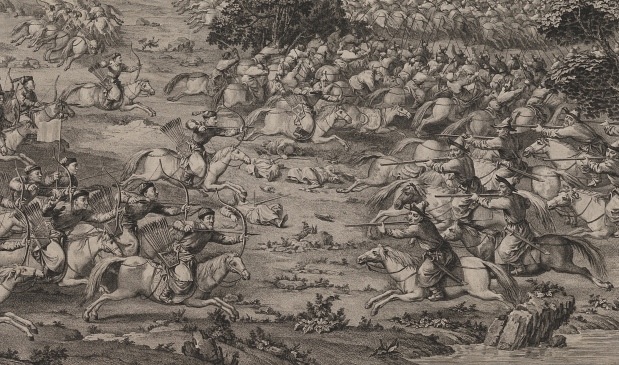
Detail of a copperplate engraving depicting the 1758 battle of Khorgos where the Qing defeated the Dzungars. Khorgos is a border town between present-day Xinjiang province and Kazakhstan. Left the Manchus, right the musket-equipped Dzungars.
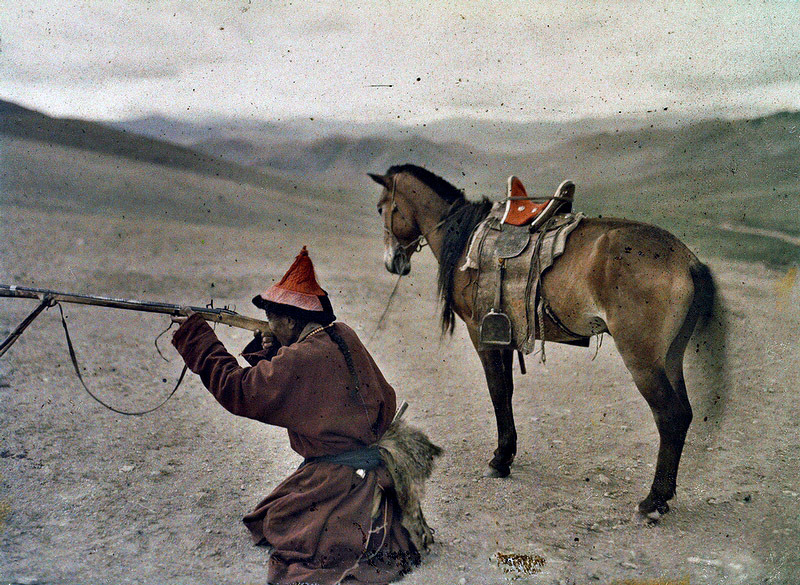
An early photograph of a Mongolian hunter with his musket in 1913. By Albert Kahn, one of the first to photograph in true color. See http://www.albertkahn.co.uk/about.html.
Evidence
Evidence suggests that Mongolians outside the Qing, at least the Dzungars, had already started to rely on firearms on their own initiative by the 18th century. These weapons would have been readily available to them through the silk-road trade since the 16th century. That sounds like blasphemy for those who like to imagine the Mongols as "the" archery culture of Asia. But it is not at all that unreasonable when you consider that other great armies of archers had done exactly the same by this time: Japanese Samurai, Ottoman Janissaries, Indian Mughal warriors, the Persians, Koreans, etc. had all made the switch to muskets introduced into Asia by (mainly) the Portuguese in the 16th century. (The idea that Samurai also used firearms is about as unpopular as the idea of Mongols used them, but they did. Don't believe everything you see in Hollywood movies!) In fact, the 18th century is a really late period for any army to still practice archery. The Manchus were the very last empire to take archery out to the battlefields on a large scale.
And then we find mention of Mongolian guns: The weapon section of the 1759 and 1766 (Qianlong period) editions of the 皇朝禮器圖式 (Huangchao Liqi Tushi or "Illustrated Precedents of the Ritual Paraphernalia of the Imperial Court") makes special mention of a variety of Mongolian muskets, further strengthening the idea that many Mongol troops had already started to switch to guns prior to Qing rule. Not only that, they even developed their own styles of this weapon, no less than five of them in this book while there are no mentions of specific Mongolian bows or arrows, it is all Manchu archery equipment.
In fact, gun use in Inner Mongolia became so widespread that the Qianlong emperor was getting worried about the archery skills of his elite Solon in the area. On the dingchou day of the 10th month of the 15th year of the Qianlong reign (November 6, 1750), the emperor issued the following edict:
The original vocation of we Manchus focused on riding horses and shooting. Ordinarily, in hunting, we had no need for guns, and only used bows and arrows. Previously, when the Solon hunted in a battue, they never used guns. Now I hear that they do not do things using bows and arrows anymore, but instead seek what is convenient, and have generally become accustomed to using guns. The use of the bow and arrow in hunting is a longstanding custom, and a principle suitable to diligent practice. Moreover, the Solon are hunters, and certainly should be proficient in archery; for this reason, among our crack troops, they have always been especially commended for their skill. If they think only about obtaining game the easy way, with time their traditional archery skills will certainly weaken. Send this to General Furdan and order him to rigorously convey this edict to his Solon men. Henceforth when mounting a battue, they must abide by the old rules and use bow and arrow to hunt game. For each gun currently in their possession, give them one tael of silver; collect them all without exception. My thinking is that these guns must also come from their own sources, since [the soldiers] certainly do not make them themselves. Now, once the prohibition has been implemented, we must ascertain clearly the actual number [of these weapons] and store them securely.
Let Furdan take extreme care in counting and collecting them. After they have been collected, strictly prohibit their illicit purchase and production, and ferret out and promptly punish violators. In addition, issue explicit instructions to the Solon: “The reason we are now collecting your guns is particularly because in hunting too many of you do not use bows and arrows, but instead are learning to use guns. His Majesty desires that you not abandon your old ways, but return to your original vocations. You all should follow the example of His Majesty’s compassionate guidance and sincere intention: when you go to hunt in battue, do not use guns, but, as before, use bow and arrow; you must return to the old customs. Those who not only excel [at archery] but also adeptly shoot from horseback can receive the favor of being raised to official ranks like Imperial Guardsman.” Use this to clearly instruct them.
Read the full article by Hing Chao in the Manchu Studies Group.
The 1803 (Jiaqing period) edition of the 欽定軍器則例 (Qinding Junqi Zeli or "Imperially Commissioned Regulations and Precedents on Military Equipment") shows that the Mongol bannermen of the capital Eight Banner troops were equipped the same as Manchu bannermen: Manchu quiver, Manchu bow, arrows, waist-worn saber. Standard Qing military gear, just like what you see on the two portraits in the beginning of the article. It starts to sound less like a ban and more like Manchus getting the Mongols back into their archery game.

Left: One of five Mongolian muskets illustrated and described in the 1766 皇朝禮器圖式. Right: A page from the 欽定軍器則例 showing the standard equipment of the Mongolian cavalry under the Qing army.
And then lastly, if there was a law on banning archery among Mongolians, where is this law recorded? Which emperor decreed it? And when? The Qing administrated everything. If a law was passed to ban archery from Mongolia, it would have been in the records. But so far nobody has been able to present historical evidence for such a law. In fact, we find the opposite: The Qing government organized many archery events to promote archery among Manchus, Mongolians, and even their Chinese subjects. They were not afraid of it, they embraced it. It was actually this deep connection with archery that was one of the reasons behind the decline of the Qing. Their archers had beaten many armies of musketeers so they did not see the need to make the switch. Once they realized they were no match for modern western breech loaders, there was no time or budget anymore to make the switch.
Conclusion
With all leads tracing back to hearsay, we can safely assume this myth to be busted.. I would like to go even further, and state that the opposite is true. Looking at the facts it looks as if the Manchus re-popularized archery among their Mongolian allies. This explains why today’s Mongolian traditional bow doesn’t look anything like the bows used in the times of Genghis Khan. Instead they are shortened versions of Manchu military bows, adjusted in this way in the 20th century to make them more suitable for sports rather than war. Where the typical Manchu military bow originally came from, we don't know. It might very well have Mongolian influences in it, I would be surprised if it didn't, but there so little material to study about pre-Qing Manchus and Mongolians that we might never be sure. Please let me know if you have any evidence to either confirm or disprove any of my claims. I'd be happy to add it to the article, with due credit to the contributor.
Further reading
Nicola Di Cosmo and Dalizhabu Bao: "Manchu-Mongol Relations on the Eve of the Qing Conquest", Brill, Leiden, 2003.
Nicola Di Cosmo: From Alliance to Tutelage: A Historical Analysis of Manchu-Mongol Relations before the Qing Conquest.
Mark C. Elliott: "The Manchu Way", Stanford University Press, 2001.
Pamela Kyle Crossley: "A Translucent Mirror, History and Identity in Qing Imperial Ideology", University of California Press, 1999.
Also see:

